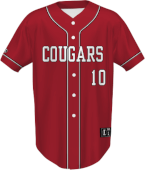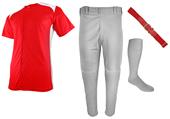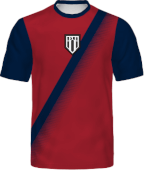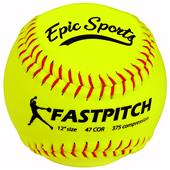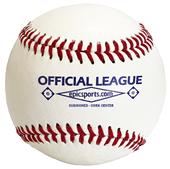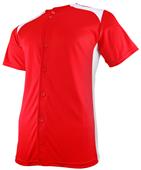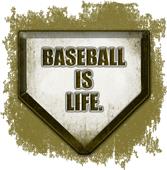There are many things to consider when shopping for the right baseball or a softball. The differences between them, how different features affect the value and performance of a ball, what performance ratings mean, how baseballs differ from softballs, and what the best ball for your league might be. Not all baseballs and softballs are created equally. You'd be surprised at just how many different kinds of baseballs and softballs there are, and all the features there are to choose from. Below are answers to these, and other frequently asked questions about baseballs.
- How should I shop for a baseball?
- What is a baseball made of?
- What are the different kinds of baseballs?
- What are the different kinds of softballs?
- Are softballs really soft, and how are they different than baseballs?
- Who invented the baseball?
How should I shop for a baseball?
While baseballs may appear the same on the outside, they're not created equally. With a little knowledge about what's in a baseball, and how they can be different, you'll be better prepared to make the right choices. Let's discuss a few of the features you should be aware of when shopping for the right baseball for your league or club, such as materials, construction, and safety.
Materials and construction:Most baseballs consist of a solid core wrapped in tightly wound string or yarn, covered by a leather or synthetic case.
Elements of making a baseball:
Core: Hidden deep in the heart of a baseball lies a small solid core. A core is usually one of three kinds - cushioned cork, rubber, or a hybrid of both. Cushioned cork is a small amount of cork, about the size of a grape, wrapped in a couple thin layers of highly elastic rubber. Cushioned cork is very dense, and is at the center of most premium baseballs for its performance properties. High school and college baseball teams may use baseballs with less dense cores. Baseballs with combination cores are ideal for practice and for use by youth teams.
Windings: Cork centers wound with wool and cotton yarn give the baseball just the right springboard effect. The tighter the winding, the bouncier the ball. Major League baseballs use at least 85 percent wool. Wool winding does the best job of helping a baseball rebound back into its original shape after impact, which helps extend the life of the baseball. Some of the cheapest baseballs have only a core and no winding, and yet still feel like real baseballs. While they don't meet performance standards, they often make ideal practice balls.
Cover: Most premium baseballs feature full-grain leather casings, but less expensive ones can have good leather-like synthetic covers. Both have their advantages. Leather is porous and offers a better grip, is more durable, and performs well. Durable synthetic covers, typically vinyl, resist water and dirt but may not grip or perform as well. Some argue that synthetic covers perform just as well as leather. It really comes down to preference, level of play, and your budget.
Stitching: Baseball covers are sewn together using two kinds of stitching - raised and rolled. Raised stitching gives the seams a textured feel that makes baseballs easier to grip and control, and is great for beginners, instructors, and recreational ball. Most major league baseballs are finished with rolled stitching for its minimal air resistance and comfortable grip.
Ball safety
Technologies have been put into place that ensure the safety of baseballs and softballs on impact. Different leagues call for balls with varying safety standards. Two kinds of balls have been designed with safety in mind; reduced-injury balls, and safety balls. Reduced-injury balls feel like game balls, but have synthetic cores that are lighter and softer than those of regulation balls, making them safer on impact. They're great for beginners and batting practice. Safety balls are synthetic lightweight baseballs that are soft to the touch. They're deal for very young beginners.

Premium game baseballs consist of a small round cushioned cork encased in two layers of rubber, wrapped tightly in wool and cotton yarns, surrounded by a thin layer of tweed, and covered by two pieces of full-grain cowhide, stitched together.
What are the different kinds of baseballs?
Though baseballs may look and feel the same, not all are created equal. Baseballs offer different features for different purposes. Difference kinds include practice baseballs, youth tournament baseballs, high school and college tournament baseballs, and professional baseballs. There are also reduced-injury, and safety baseballs. Baseballs feature different cores, covers, and stitching. Knowing about the different kinds of baseballs and their features might help you narrow down which ones will meet your needs.
Practice Baseballs: Practice baseballs can be used for training and pitching machines. They're generally of lower quality, but look and feel like real baseballs. Training baseballs can be molded synthetic, leather, or a combination. Practice baseballs have combination cork and rubber centers. The up-side to practice balls is they're inexpensive and easy to replace if lost. Soft practice baseballs are great for indoor training.
Youth Tournament Baseballs: Youth baseballs are designed for aluminum bats, and are a little lighter than those used in the adult leagues. They have a soft cork center, and are wound less tightly. Youth baseballs can be used in little league tournaments.
High school and college baseballs: They're like professional baseballs, but are lighter in density and generally designed for aluminum bats
Professional baseballs: The highest density and quality; used for major and minor leagues, and generally used with wood bats.
Reduced-injury baseballs: These balls feature a softer core, and are often used for practice. Better than safety baseballs, but softer than regulation baseballs.
Safety baseballs: These synthetic, lightweight baseballs are designed to be used in the beginner leagues, such as tee ball. They're soft to the touch, and perfect for small aluminum bats.
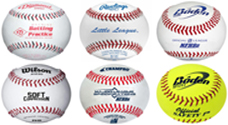
Cores, Covers and Stitching:
Cores - Most baseballs contain one of three kinds of cores: cushioned cork, rubber, or a combination of the two.
Covers - Most baseball covers are either leather, or leather-like synthetic. High performance balls use full-grain leather, but leather-like baseballs work great too and are more economical.
Stitching - The standard baseball contains either raised, or flat stitches.
What are the different kinds of softballs?
If you thought baseballs were complicated, they're nothing compared to softballs! Softballs come in difference sizes, dimensions, colors, and scientific ratings. Let's simplify things. There are two general differences between softballs: size, and performance.
Size: Softballs are available in a range of sizes. The two most widely used are 11-inches in circumference, used by kids ages 10 and under, and 12-inch, which is standard for youth and adults.
Performance:
Compression rating vs. COR rating. What do they mean, and what's the difference?
There are two ways to measure a ball's performance; compression ratings, and coefficient of restitution, or COR. Compression is the most important indicator of performance.
Compression rating: Aside a softball's size, color, and other variations, compression ratings are used to categorize how safe a ball is. A compression rating measures the ball's firmness. The higher the compression, the firmer, or bouncier the ball, and the farther it's likely to travel when hit. Put another way, compression is the amount of force needed to compress the ball one-quarter of an inch. For example, if it takes 375 pounds of force to squeeze the ball by one-quarter of an inch, the ball is rated a 375-pound compression ball. This is different than a softball's COR rating, or the speed at which a ball bounces off the bat, and rebounds from its compressed state back to its original state. Softball compression rates vary according to the league-approved softball. The ASA has approved two levels of compression - 375 pounds, and 525 pounds.
COR rating: Coefficient of restitution, also known as collision efficiency, is the ball's rate of speed coming off the bat. If a ball strikes a bat at 60 mph, but is only traveling 30 mph off the bat, its speed was reduced by half; so its COR rate would be 50. The higher the rating, the faster the ball rebound. The ASA has established six possible performance ratings based on combining compression rates with the COR rates.
To know which ball rating is right for your team, you'll need to consult your league rules as different leagues approve different compression ratings. In general, young players and slow-pitch leagues will use balls with a lower rating, or balls that rebound slower off the bat; adult players and fast-pitch leagues will use balls with higher ratings, or balls bouncing faster off the bat. Once you know your league's correct ball rating, make sure to check the markings on the softballs.
Are softballs really soft, and how are they different than baseballs?
Contrary to what we might think, league softballs are not softer to the touch. They're called "softballs" because the core is softer than that of the baseball, causing it to bounce off the bat more slowly. The main differences between baseballs and softballs involve size, materials, color, and performance.
Size:
Baseballs vs. Softballs - Baseballs measure up to 9-1/4 inches in circumference, and weigh about 5-1/4 ounces. Unlike baseballs, which are all the same size regardless of league, softballs come is a variety of circumferences: 16-inch, 14-inch, 12-inch (standard), 11-inch, and 10-inch.
Materials:
Baseballs - are constructed of wool yarn wound tightly around a center core made of a cork, rubber, or combination of the two, covered by two strips of full-grain leather stitched together to create a raised or flat stitch seam.
Softballs - cores are made from either long fiber *Kapok (cotton-like substance), a combination cork and rubber, polyurethane, or other approved material, encased in leather or synthetic leather sewn together using a flat stitch.
Color:
League baseballs are white with red stitching, while most league softballs are optic yellow, or in some cases white, with red stitching.
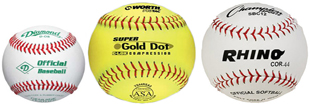
Performance:
Softballs, more than baseballs, come in various firmnesses which affect their bounce. The basic difference between a softball and a baseball is the speed at which the ball comes off the bat. Softballs are slower coming off the bat than a baseball. Since softballs compress more than baseballs when they hit the bat, they take longer to rebound back to their normal shape.
Who invented the baseball, and when?
The modern baseball is akin to its English predecessor, the Cricket ball - a small, hard, leather-covered ball with a solid cork center used for playing Cricket. American baseball came out of the game of rounders', which used a soft ball. Rules written in 1845 called for replacing rounders' soft ball with a smaller, hard ball.
The earliest baseballs were entirely handmade by players and local merchants. They featured a solid core wrapped in yarn or string and covered in a single four-sided piece of leather, stitched together to form "x". Since baseball's invention in 1839, and throughout the 1850s and 1860s, many changes have been made to the ball's core, wrappings, casing, stitching, size, and weight. In 1954, three New York baseball teams set the baseball's weight at up to 6 ounces, and its diameter up to 3-1/2 inches. The first baseball convention in 1957 decided upon a slightly larger baseball, one that would measure up to 10-1/4 inches in circumference, and weigh up to 6-1/4 ounces - a bit larger than today's 5-1/4-ounce baseball.
The first factory-made baseballs were produced by Harwood and Sons, in Mass., in 1858. The same company also made the first baseballs covered by two pieces of leather stitched together to form a figure-eight design. The ball's core construction continued to be improved on, and rules for that were created. A.G. Spalding patented the first cushioned wood core in the late nineteenth century.


